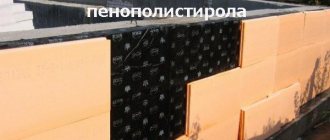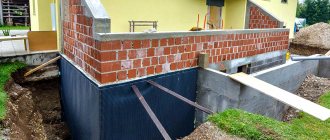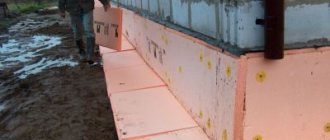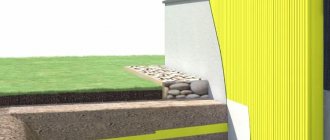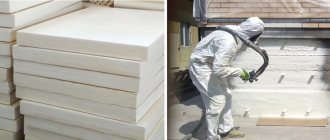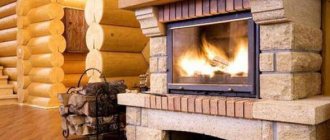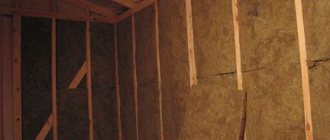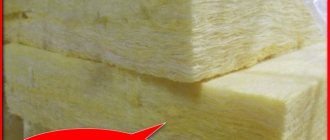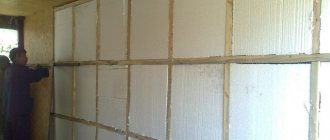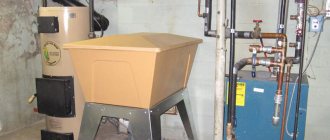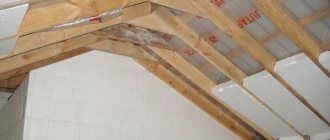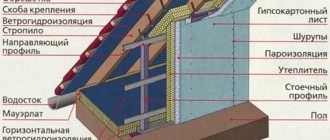High-quality and reliable thermal insulation ensures comfort and coziness in the home, while saving financial costs and maintaining a high environmental level of the premises. Partial finishing of the building does not retain heat, letting cold inside through unprotected areas. This often happens due to the fact that the foundation of the house was not insulated with polystyrene foam. Of course, other materials can be used to decorate this area of the building, but they are not always able to properly perform their functions. Therefore, we will tell you in this article what properties polystyrene foam has and how to properly insulate it.
The need for thermal insulation of the foundation
Insulating the foundation of a basement
Insulating the foundation of a private house with polystyrene foam from the outside is mandatory. This also applies to other buildings, especially those containing a basement. To achieve high-quality results in installing thermal insulation, many use foam plastic.
A poorly insulated building loses up to 50 percent of heat through holes in the insulating coating, causing additional economic costs for heating. A fatal mistake when installing house insulation is neglecting the thermal protection of the foundation, believing that it will be enough to just finish the walls of the structure.
You should know! A large amount of heat escapes to the street through elements in contact with the soil. Uninsulated basements, foundations and the first floor of a building suffer especially greatly from low temperatures in winter.
Good thermal insulation of the base is characterized by two functions:
- minimizing heat consumption;
- Preservation of the foundation from freezing and deformation.
The fact is that the predominant type of soil in our country is heaving. Due to the effects of cold, the depth of soil freezing can be several meters. During a thaw, the volume of soil changes, which in turn negatively affects the structure of the foundation of the house.
Before starting installation work, it is necessary to take into account that the installation of the thermal insulation coating must be complete. The presence of any cracks, defects and parts in the insulation layer has a detrimental effect on the building’s ability to maintain a temperature suitable for comfortable living. Only a dense air layer containing an insulation ball can completely contain the loss of warm air.
Horizontal installation method
Slab foundation insulation scheme
Horizontal insulation is used for slab and strip foundations, for which polystyrene foam up to 10 cm thick is used.
Step 1. First, the site is cleared of soil, leveling the bottom, the last few centimeters are removed manually.
Step 2. The base is covered with sand, which needs to be compacted.
Step 3. Temporary formwork is performed, which is filled with a layer of concrete without reinforcement.
Step 4. Then, when it hardens, laying the slabs begins.
Step 5. A thick film is placed on top as waterproofing, which is glued with tape.
Step 6. Formwork is made, then reinforcement is made and the foundation is poured.
Step 7. When the formwork hardens, it is removed and additional thermal insulation of the side walls is performed.
Installed insulation
Video - Monolithic slab foundation. Insulation and waterproofing
Video - Monolithic slab - technology
Insulating the foundation using polystyrene foam
Polystyrene foam is not able to collapse when in contact with asphalt or paving slabs
*
Among the many insulation materials for the foundation, including mineral wool, glass wool and expanded clay, the most suitable material should be noted - polystyrene foam. Due to its ability to maintain its functions in any climatic conditions, the product has gained incredible popularity among builders.
The characteristics of polystyrene foam are reliability, low cost and ease of use. In addition, its main component is air, which itself has excellent thermal insulation properties.
Foam plastic for foundation insulation has the following properties:
- stability when interacting with asphalt and concrete;
- resistance to water and fire;
- ability to retain heat;
- resistance to temperature fluctuations;
- maintaining shape and volume when exposed to external factors.
A significant disadvantage of polystyrene foam is fragility. To prevent the formation of various defects on it, the surface should be treated with glue.
Polystyrene foam is recommended for insulation of foundations built on clay soil. In addition, it is an excellent insulation option designed for underground use. This is due to its good moisture resistance and resistance to sudden temperature changes.
Types of foam plastic for insulating the foundations of houses:
- press - plate, foam thickness - from two centimeters;
- tiled polystyrene foam, parameters – 1*1*0.05 m;
- polyurethane foam (liquid);
Most often, foam is used for insulation. The reason for this choice is its size, which has a beneficial effect on installation and finishing procedures.
Important! In case of periodic flooding of the foundation and basement of a building, it is better to use another material as insulation.
Calculation of insulation thickness
Most manufacturers produce slabs with a thickness of 3 to 12 cm. Before insulating the foundation of a house with foam plastic, in each specific case a thermal engineering calculation is performed according to SP 50.13330.2012. This calculation takes into account the following initial data:
- type of structure (in our case, basement wall);
- outside air temperature;
- indoor temperature;
- operating mode of the building.
You can be guided by average values for a specific climatic region. In most cases, for central Russia, the thickness of the foam is 8-10 cm. In warmer climates, consumption can be reduced.
Diagram of heat loss through the foundation.
Advice! For accurate calculations, you can use special programs (for example, Teremok). In this case, it is possible to select an external wall as the calculated structure. But it’s worth checking the temperature and humidity indicators in the basement (they may differ from those indicated by default).
What is needed when insulating the base
Digging a trench to the depth of soil freezing
The initial stage of foundation insulation is preparation for the start of work. To ensure quality and reliable results, it is necessary to remove the frozen soil cover. Next, you should clean the base of the plinth from the remaining soil and treat its slabs with a primer.
To save money, you can make the primer yourself. It is necessary to mix the melted bitumen with gasoline or diesel fuel, maintaining a one-to-one ratio (the amount of diesel may be greater). After one hour, when the primer mixture has dried, a ball of waterproofing should be applied. This procedure is on a par with insulating the foundation, and therefore is mandatory.
Liquid rubber and rolled bitumen can be used as waterproofing materials. In the first case, you should mix the substance with a mixer and then cover the foundation with it using a spatula. Bitumen rolls are attached to the base after they are heated. The algorithm of actions is as follows: measure the roll height, cut off the strip, return the roll to the rolled state, heat it with a burner, roll it back and attach it to the surface of the foundation. The installation procedure for soft roofs is slightly reminiscent of this work.
Installation of expanded polystyrene boards
Applying a waterproofing layer
*
The foundation insulation technology involves attaching slabs to the surface of a waterproofing ball. To do this, use bitumen polymer mastic or polyurethane adhesive. It should be applied over the entire coating or to certain areas. The presence of gasoline, acetone and toluene (organic solvents) in the glue causes the destruction of polystyrene foam boards, reducing the service life of the thermal insulation. Therefore, it is necessary to first pay attention to the composition of the mixture.
Recommendation! To achieve a layer size of 10 cm thick, it is better to use an overlay of two sheets of 5 cm each. This will help prevent the formation of cracks and defects. A new ball should be started only after the glue on the laid one has completely dried.
It is not recommended to fasten the slab mechanically. The fact is that in this case the integrity of the waterproofing layer suffers, causing moisture to enter the basement floors. Typically, foam boards have special recesses that are designed to be attached to each other without the appearance of various holes. The contact point of the foam boards should be treated with mastic or glue.
Insulation with a double layer of polystyrene foam
Thickening thermal insulation by bonding two layers causes different opinions. Most craftsmen recognize the benefits of this action, arguing that adhesives with insulation provide high-quality and durable combination of two balls of insulation into one. In such a situation, in order to avoid the formation of various defects at the base of the building, it is necessary to lay the slabs, excluding the coincidence of the seams of different layers.
Other opinions say that in this case there is a danger of destruction of the integrity of the thermal insulation as a result of rising soil. This can lead to water entering into the resulting cracks, which is one of the main causes of heat loss in the room.
Foam baseplates are usually installed on a rigid surface. The ideal option would be a structurally manufactured foundation overhang. As for the base for insulation, the best option would be to fill it with sand and gravel.
It is important to know! Insulation must be installed along the entire perimeter of the foundation.
Before filling the trench, you need to put a film between the soil and the insulation. When
filling a foundation with installed insulation, you must first lay a layer of roofing felt roll between the soil and the foam. On the opposite side, you can also protect the insulation using a thin wall of brick or a polyethylene membrane. This action prevents excessive contact of the thermal insulation with moisture and insects.
Installation of EPS
When the waterproofing is finished and the bitumen has finally cooled down, insulation of the foundation with polystyrene foam proceeds to the main stage. The thickness of the insulation is determined in accordance with the parameters of the foundation and the climatic characteristics of the region. For example, if the winter in the area where you live is harsh and long, it would be reasonable to lay the thermal insulation in two layers, five centimeters each.
Foundation insulation with extruded polystyrene foam
Expanded polystyrene sheets are available both corrugated and smooth. To ensure optimal adhesion to glue, the former are better suited. But if you nevertheless purchased smooth slabs, immediately before installation, treat them with a needle roller.
How to attach?
Fastening polystyrene foam below ground level requires the use of exclusively special glue that does not contain organic solvents. It is applied to the insulation with dotted strokes in the corners and in the center of the sheet. Then the insulation sheet should be firmly pressed against the foundation and held until the glue sets.
Under no circumstances should you fix the thermal insulation in the basement using dowels, as they will damage the moisture-resistant layer. Above ground, the sheets are attached to the wall with hardware three days after installation, when the glue has completely dried. Each sheet contains approximately five dowels, which are driven into holes drilled through the insulating material.
How to lay it?
EPS sheets should be laid from the corner of the house, checking the correct installation using a level. At the corners, it would be better to lay the material in two layers, with a meter extending in each direction from the corner. The slabs are mounted to each other using a connecting locking system at the edges. If there are gaps between the sheets, they are sealed with polyurethane foam sealant.
Thermal insulation protection
Thermal insulation must be protected from rodents and unexpected ground movements. There are two main protective technologies: using geotextiles and roofing felt or reinforced fiberglass mesh. The cost of the glue on which the mesh is attached is quite impressive, so it is permissible to use cement mortar instead.
Backfilling the trench
The trench dug around the perimeter of the house, after completing the insulation work, should be filled in only when all the materials are dry, including the cladding of the basement floor.
This process occurs in several stages:
- the bottom of the trench is covered with a layer of sand up to 150 mm thick;
- the sand should be moistened, leveled and compacted well;
- Expanded clay or gravel is laid on top of the sand layer, the layer thickness is from 200 to 300 mm;
- the excavated soil is poured on top of the gravel cushion and compacted very carefully;
- The trench should not be completely buried; approximately 300 mm should remain to the ground level for the blind area.
Final stage
*
If part of the insulation protrudes from the trench, damage can be prevented by using a reinforced mesh. It is installed on the top insulation ball using the gluing method.
Next, you should treat the insulating layer with any finishing material. If the base structure is located flush with the soil, installation of the mesh and final finishing work will not be required. All that remains is to close the trench space with sand, earth or expanded clay, which also has thermal insulation properties.
Advantages and disadvantages of the material
The advantages of expanded polystyrene include:
- low thermal conductivity;
- soundproofing qualities;
- moisture resistance;
- light weight;
- ease of processing (it can be easily cut with a saw or knife);
- ease of fastening;
- excellent adhesion to other materials;
- frost resistance (withstands up to -50°C);
- safety during operation (expanded polystyrene does not smell, does not generate dust and does not emit toxic fumes);
- preservation of material properties for a long time (about 50 years);
- stability under high loads;
- no shrinkage;
- biological resistance (does not mold).
Advantages and disadvantages of expanded polystyrene
Disadvantages of the material:
- flammability (special additives make it self-extinguishing);
- may release harmful substances when ignited;
- low strength;
- hygroscopicity;
- inelasticity;
- instability to ultraviolet radiation.
Insulation comparison table
